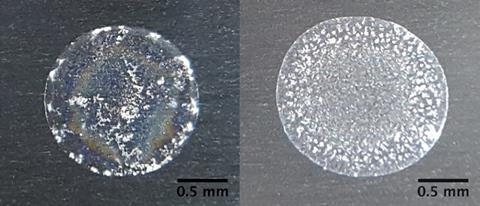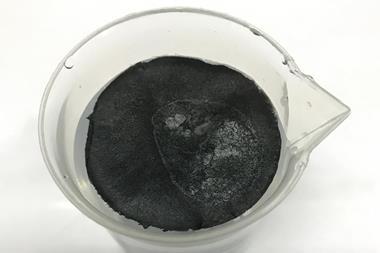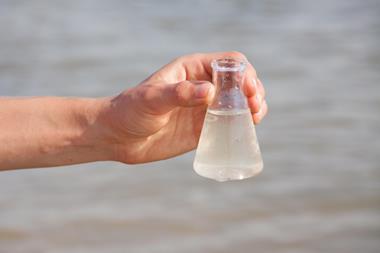Unique pattern of an evaporating droplet can be used as a fingerprint for water samples

By looking at the pattern of residues left behind after a drop of water evaporates, scientists in the US say it may be possible to develop a simple, low-cost way to investigate the quality of tap water. Their method exploits the coffee-ring effect, where water evaporates from around the edge of a droplet, pulling water outwards from the middle and leaving a characteristic mark around the edge.
Rebecca Lahr from Michigan State University explains that the effect can be observed by taking a 2µl droplet of water, letting it dry on a smooth surface and then looking at the residue left behind using a jeweller’s loupe – essentially a powerful magnifying glass – and a smartphone camera.
‘When we do that we find that the residue pattern from each tap water is unique, so we get a fingerprint of that tap water,’ says Lahr, who was presenting the work at the 254th American Chemical Society National Meeting and Exposition in Washington, DC. ‘The patterns are intricate, it’s quite interesting to see how different they can be.’
By examining images of the residue patterns, Lahr and her colleagues hope to develop ways to identify different components and characteristics of a water samples.
‘We can quantify how many particles there are using software,’ says Lahr. ‘Then we can look for correlations between particle count and concentration, we can look for correlation between the general coverage and concentration. It really depends on the solution – if you put in different concentrations of something like iron chloride you’ll get a different result to if you put in something like copper chloride.’
Fingerprint database
The eventual aim is to build up a library of patterns, and potentially a computational tool that will allow people to analyse samples of their own water at home. ‘We’re trying to develop a low-cost way that anyone anywhere in the world can look at what’s in their tap water,’ says Lahr. ‘In order to use existing tools like [test strips] you have to know what you’re looking for. If we can have more methods that can fingerprint a sample then in theory we can find problems faster.’
The idea of using the coffee-ring effect in this way came from previous work in which the group explored it as a way to concentrate contaminants such as cyanotoxins around the edge of droplet-sized water samples so they can be quantified. ‘I was doing that work with all sorts of different solutions […] you see intricate patterns all the time, and I always wondered exactly what is causing all of that,’ Lahr says. ‘The more I looked at tap water samples the more I realised it’s controlled by water chemistry, so we might be able to harness that.’
Lahr admits there is a limit to the extent water content can be analysed using this technique. While there are definitely definable differences between the patterns left by hard and soft water, for example, it is not yet possible to analyse complex mixtures of solutes or individual contaminants. ‘We’re still working on many of the details of this method,’ she says. ‘We’re really trying to harness this phenomenon, but we’ve got a long way to go with the research.’
















No comments yet